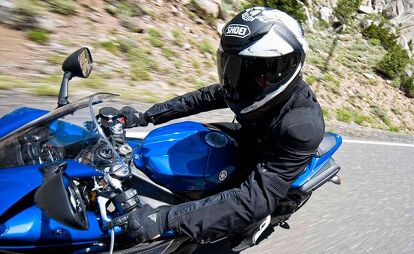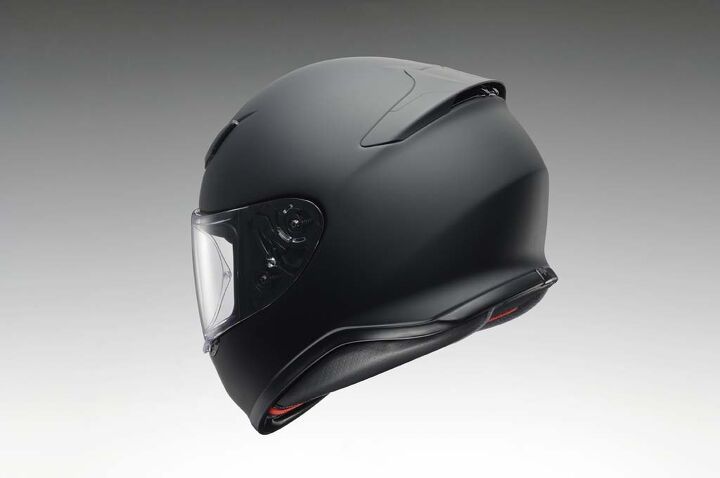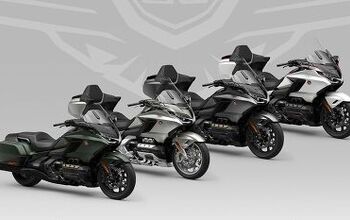Shoei RF-1200 Preview

Heads Up! The continuing refinement of Shoei's RF-series helmets
Manufacturers like to tease the press a little to keep us interested. So, naturally we were more than a little curious when Shoei announced a “top-secret press event.” Even without all the subterfuge, we would’ve been excited to learn that Shoei was replacing its popular RF-1100 helmet with the all-new RF-1200.
Released in 2009, the RF-1100 grew to become Shoei’s best-selling model. Although the RF-1100 is listed as a sport touring lid, you can see riders of all stripes wearing them, thanks to the wide variety of colors and graphic options available. With so much at stake with this update, Shoei’s engineers leaned on the breadth of knowledge garnered over the company’s 55-year history to make the RF-1200 both less and more than its predecessor.
An essential part of the RF-1200’s design process was the use of the state-of-the-art wind tunnel at Shoei’s Ibaraki factory. The testing helped to shrink the helmet’s size with the refinements primarily being made to the chin bar, the base, and the rear. The compact, more aerodynamic shape helps the helmet slip through the air with less resistance and, therefore, less noise, resulting in a higher signal to noise ratio as the rider tries to listen for important sounds through the constant roar of the air stream.
Although the integrated spoiler of the RF-1100 is gone (as are the four individual exhaust ports that dotted the top of the helmet), the RF-1200 has a plastic spoiler to achieve the same stabilizing downforce while hiding the exhaust venting hardware. The net result of the reshaping is the lightest Snell-certified helmet Shoei has ever produced. The XL model weighs in at approximately 100 grams lighter than the 1100 with the M being 50 grams less than last year.
Many riders might be surprised to learn that the bulk of helmet noise is produced at the base of the helmet. With the reduced base turbulence offered by the RF-1200, Shoei’s designers were able to use the helmet’s liner to further tune out the wind noise while not impeding “informative sounds” the rider needs to hear.
The liner itself utilizes a 3D Max-Dry System II where the pad components are shaped to closely mimic the curves of a rider’s head, providing both comfort and the secure fit required for performance riding. If your noggin doesn’t perfectly match Shoei’s template, the RF-1200’s cheek pads can be purchased in different thicknesses. The Max-Dry construction of the pads means that sweat is wicked away from the rider’s skin twice as fast as Nylon materials. The liner parts are also removable for laundering, keeping your helmet from smelling like an old gym sock after a long, hot, humid summer.
While we don’t usually think of cheek pads and their accompanying liners as an important safety feature, Shoei’s Emergency Quick Release System (E.Q.R.S.) allows for easy removal of the cheek pads by emergency medical technicians. With the pads removed, the amount of stress transferred to the rider’s neck as the helmet is removed is significantly reduced.
Another portion of the liner that is easily removable — though for more pleasant reasons — is the pad covering the speaker cutouts. Riders who want to install communication systems into their helmets will find the RF1200’s liner quite amenable to the fitment of speakers. An easily installable breath guard and chin curtain are also included.
A motorcycle helmet has two key features that protect our delicate craniums. The first, hard layer spreads out the force of the impact over a larger area. The RF-1200 uses a multi-ply matrix combining fiberglass and organic fibers for lightness and strength. Shoei claims that its AIM+ shell is so strong that it “can only be cut with a laser.”
Inside the protective covering, the Expanded Polystyrene (EPS) liner serves several purposes, most importantly the attenuation of impact forces in a crash. The RF-1200’s EPS liner features a dual-layer, multi-density construction. The variable density EPS is distributed throughout the helmet to give location specific impact protection while still maintaining a compact and lightweight design. The dual layers of EPS also allow for optimal ventilation by directing fresh, cool air through free-flowing tunnels.
The RF-1200’s ventilation system was wind tunnel tested to strike a compromise between air-flow and wind noise. The chin bar sports a large vent with a three position shutter that can be operated with a gloved hand. The forehead area gets a center vent in addition to the RF-1100’s dual upper intakes. The RF-1200 hides four exhaust ports under the molded spoiler whereas the RF-1100 had four separate vents on the top back of the helmet. All of these changes should add up to effective cooling without adding excessive helmet noise.
Shoei claims that the RF-1200’s eye port allows for a view angle that compares favorably with unencumbered peripheral vision. The CWR-1 shield fills that open space with optically clear plastic that protects your eyes from wind, dust, and 99% of UV radiation. The RF-1200’s shield gained supporting ribs at the top and bottom of the shield for extra stiffness. While you may think that this would only be helpful in maintaining the shield’s shape when it was undergoing the torque of being opened and closed, Shoei claims that the rips prevent shield flex during high-speed riding. The shield also received a new, more secure locking mechanism that is similar to the GT Air’s.
The ribbed shield mounts to the new QR-E baseplate system. Shoei’s RF-series helmets have always allowed for quick shield changes, and the new system is supposed to be even quicker. Weather sealing is improved by a five-position adjusting dial which fine-tunes the pressure that the spring-loaded base plates apply to the shield. Finally, dual-layered beading provides the actual seal between the shield and the helmet, keeping the elements on the outside where they belong. Fans of the Pinlock Fog-Resistant System will be happy to know that the CWR-1 shield has Pinlock mounting tabs.
If our past experience is repeated, Shoei has taken an already great helmet and made it better with this bump in the RF numeration. Testing will have to wait until the XL sample we’ve been promised arrives in our sweaty hands in the next couple weeks. The RF-1200 will ship in sizes ranging from XS-XXL. Four shell sizes are used to accommodate the range. A variety of graphics patterns will be available for $590. The solid colors will be priced at $486, and metallics bump the price to $499. Find out more at www.shoei-helmets.com.
Shoei RF-1200 | |
| + ProsImproved aerodynamicsImproved face shield seal for quietnessShoei’s premium fit and finish | – ConsLong-to-medium oval only, round heads need not applyForehead vents contribute to helmet noiseBeen usurped by the Shoei RF-1400 |
Shoei RF-1200 FAQ
Is Shoei worth the money?
Shoei is a premium helmet manufacturer, which means you get far more than a helmet that simply meets federal impact standards. Each Shoei helmet is handmade, and by the time it is packaged for shipment, it has been handled by more than 50 people as part of the stringent manufacturing and verification process. Additionally, premium helmets, like Shoei, typically offer superior comfort features such as effective venting, removable and adjustable liners, and high-quality fit-and-finish. Shoei helmet owners see the value in their comfort and finish for their extra dollars.
When was the Shoei RF-1200 made?
The Shoei RF-1200 has been in production since 2014. Although the RF-1200 has been replaced by the Shoei RF-1400, it is still currently (June 2021) being sold at a significant discount. However, at some point the helmet will go out of production and become scarce. Until then, thanks to the lowered price, the RF-1200 has all of the benefits listed in this article at a more wallet-friendly price. If you’ve be interested in buying a Shoei but didn’t have the money, now might be your chance.
Which is better, Shoei or Arai?
Both Arai and Shoei are premium helmet manufacturers that are renowned throughout the world. Both produce high-quality hand-made helmets with superior fit and finish. However, they each have slightly different philosophies when it comes to designing and manufacturing helmets. Additionally, their models will fit slightly different head shapes. Since fit is of primary importance when it comes to helmets, trying on models by both brands will help to determine which is best for your head. You can’t go wrong with either brand.
Shoei RF-1200 Specifications | |
|---|---|
| Price | $486 (solid), $590 (graphic) |
| Sizes | XS-XXL |
| Weight | 3 lbs, 8 oz. (approximately) |
| Colors | White, Black, Light Silver, Brilliant Yellow, Shine Red, Wine Red, Matte Black, Black Metallic, Anthracite Metallic, and various graphics |
Additional Resources
MO Tested: Shoei RF-1400 Helmet Review
MO Tested: Shoei X-Fourteen Review
Best Modular Motorcycle Helmets
Best Motorcycle Touring Helmets
Best Motorcycle Racing Helmets
The 10 Best Motorcycle Helmets You Can Buy Today
HJC IS-17 Helmet Review
Biltwell Gringo Helmet Review
Custom Fit Bell Star Carbon
Shoei Neotec Helmet Review
2012 Shoei RF-1100 Helmet Review
Shoei RF1100 Helmet Review
We are committed to finding, researching, and recommending the best products. We earn commissions from purchases you make using the retail links in our product reviews. Learn more about how this works.
Become a Motorcycle.com insider. Get the latest motorcycle news first by subscribing to our newsletter here.

Like most of the best happenings in his life, Evans stumbled into his motojournalism career. While on his way to a planned life in academia, he applied for a job at a motorcycle magazine, thinking he’d get the opportunity to write some freelance articles. Instead, he was offered a full-time job in which he discovered he could actually get paid to ride other people’s motorcycles – and he’s never looked back. Over the 25 years he’s been in the motorcycle industry, Evans has written two books, 101 Sportbike Performance Projects and How to Modify Your Metric Cruiser, and has ridden just about every production motorcycle manufactured. Evans has a deep love of motorcycles and believes they are a force for good in the world.
More by Evans Brasfield










































Comments
Join the conversation
Do you think shoei will release a new iteration of this helmet anytime soon? Like an rf 1300?